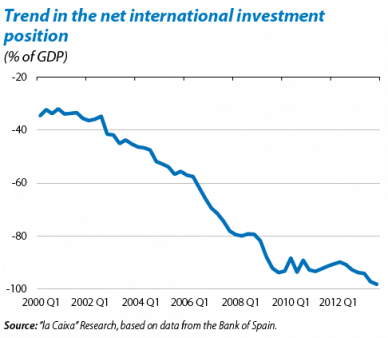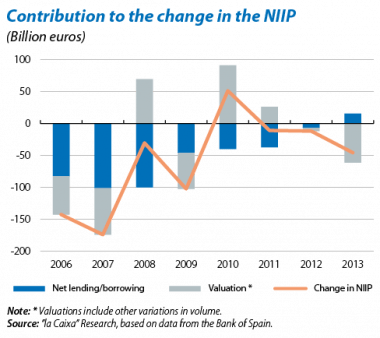Among the various imbalances accumulated by the Spanish economy in the years prior to the crisis, one of the toughest to correct must surely be its high external borrowing. A good example of this is the recent trend in its net international investment position (NIIP); i.e. the difference between the foreign assets held by Spanish citizens and Spanish assets in foreign hands. This article briefly reviews the main factors that determine this trend and its prospects.
The NIIP fell very sharply between 2000 and 2009, going from –32.0% of GDP to –93.8%. This negative trend has slowed down since then but, although the Spanish economy now has a net lending position, its NIIP has yet to improve. The logic seems simple: if an economy such as Spain's has a positive current account balance, it can either use its assets to pay off its external liabilities or to buy external assets. In both cases, its NIIP would improve. It therefore seems paradoxical that Spain's NIIP should continue to worsen.
However, the NIIP's trend does not only depend on an economy's net stock of financial assets with the external sector; changes in the relative value of its assets and liabilities also play an important role, especially over the short term. The second graph shows each factor's contribution to changes in the NIIP over the last few years. As can be seen, in 2013 Spain's net lending position, namely 1.5% of GDP, helped to improve its NIIP. However, this was not enough to offset the valuation effect, which was negative in 2013. In other words, the price rises in Spain's assets held by foreign citizens were greater than the price rises in foreign assets held by Spanish citizens. This valuation effect was particularly significant among equity. By way of example, in 2013 the Ibex 35 gained 21.4% while the average gain for Eurostoxx 50, MSCI Emerging Markets and S&P 500 remained at 14.0%.1
However, it should be noted that, although valuation can have a significant effect in any one year, in the long term the NIIP's trend is determined mainly by an economy's stock of financial assets with the external sector. For example, this lies behind 85% of the change in the NIIP in the last seven years. Assuming the valuation effect is not so important in the long term, if Spain's net lending position remains at 1.5% of GDP in the future and nominal GDP grows by 4%, by 2020 its NIIP will be close to –65%. A significant drop but still keeping the NIIP far from the threshold set by the European Commission, namely –35%. Therefore, in spite of the considerable push by exports over the last few years, efforts to improve the Spanish economy's international position must continue.
1. Eurostoxx 50 rose by 17.9%, MSCI Emerging Markets fell by 5.3% and the S&P 500 rose by 29.6%.

